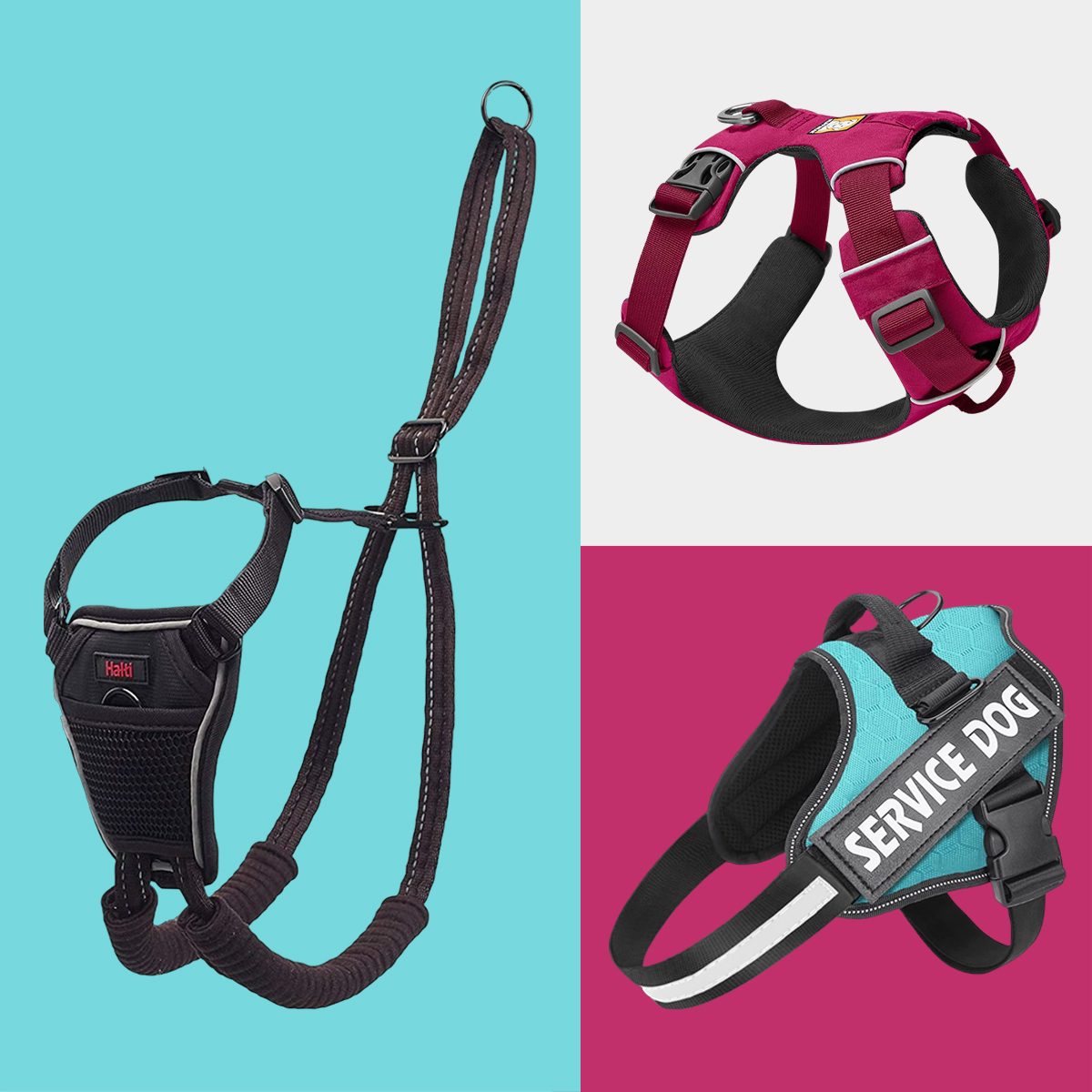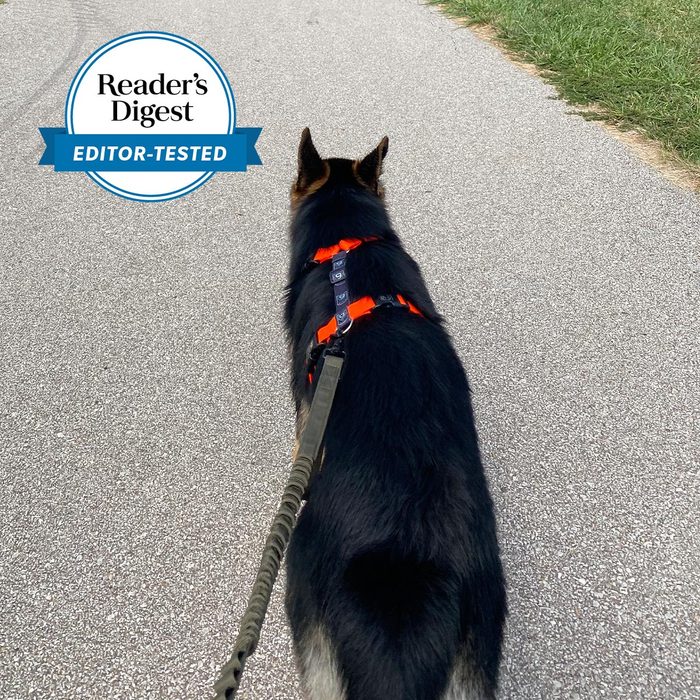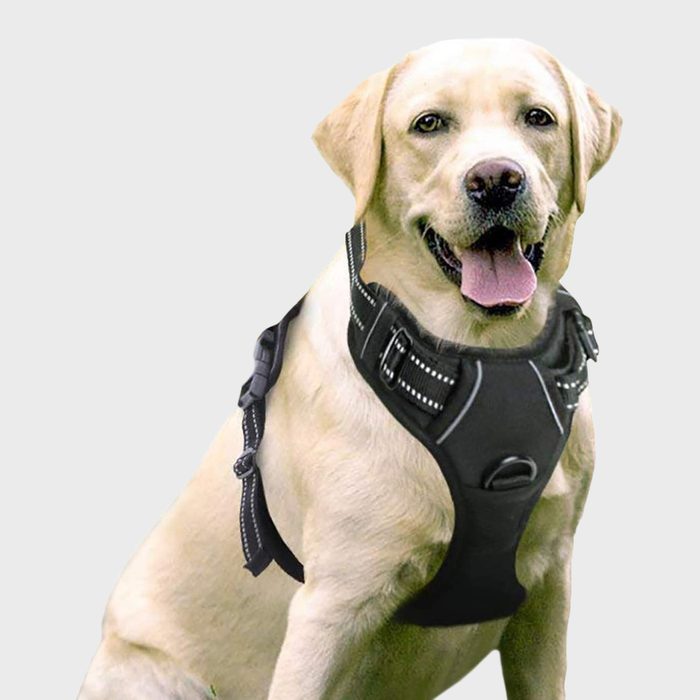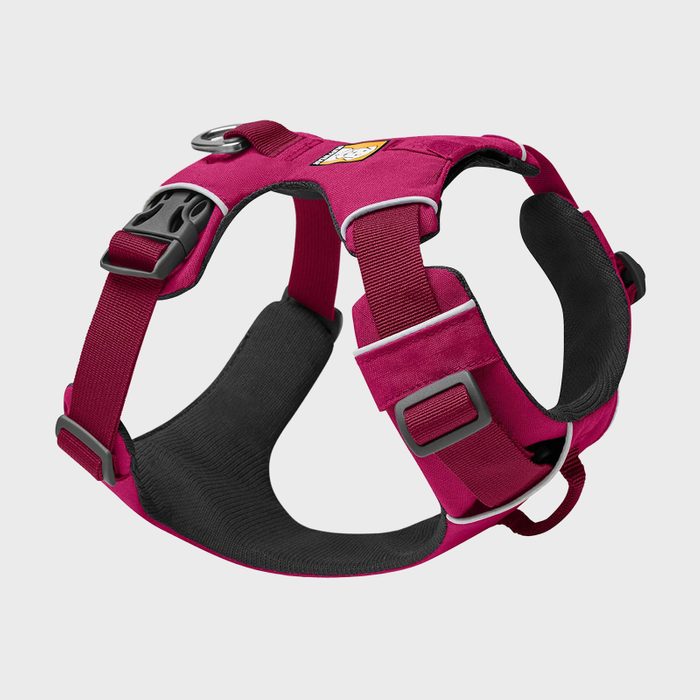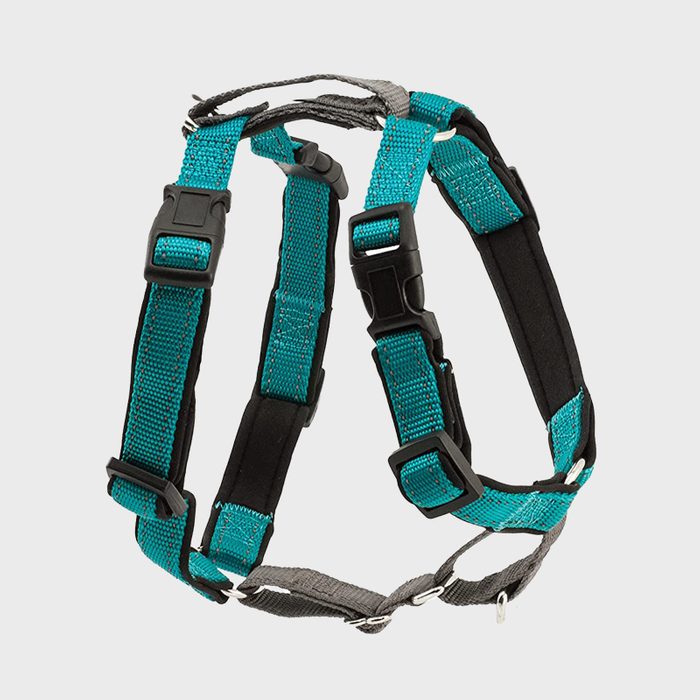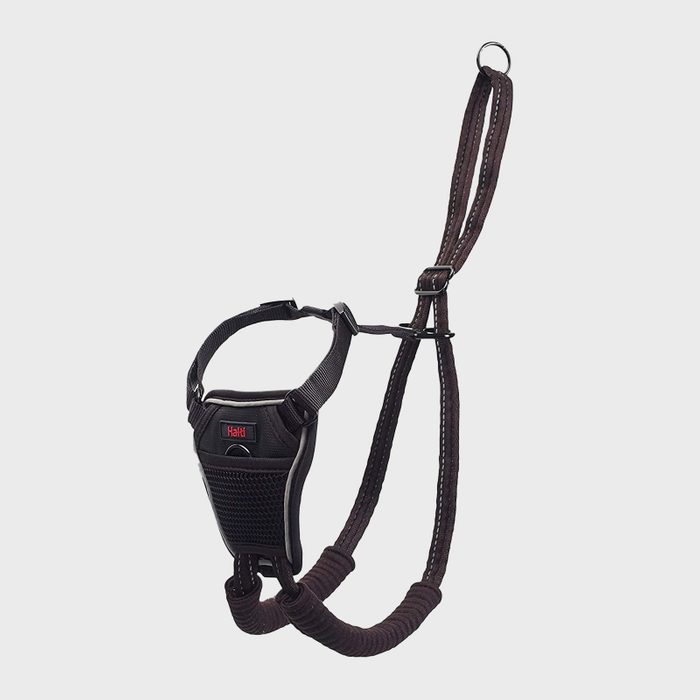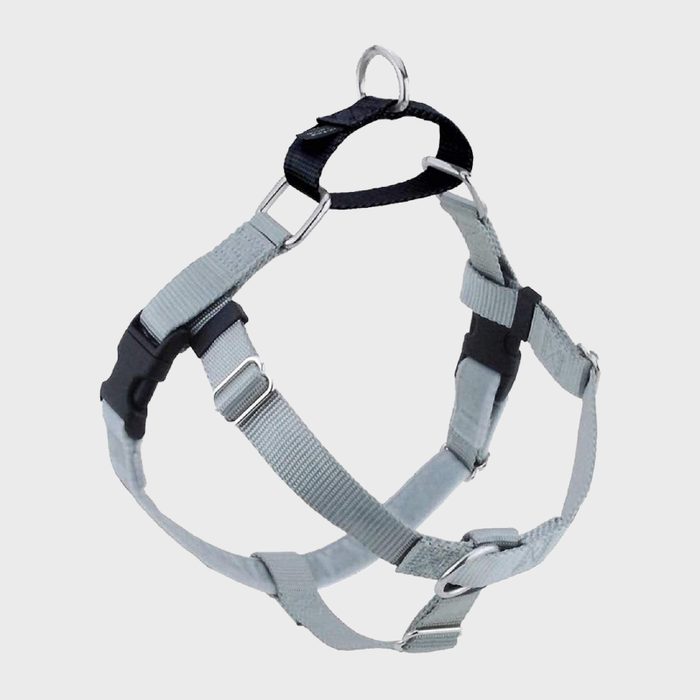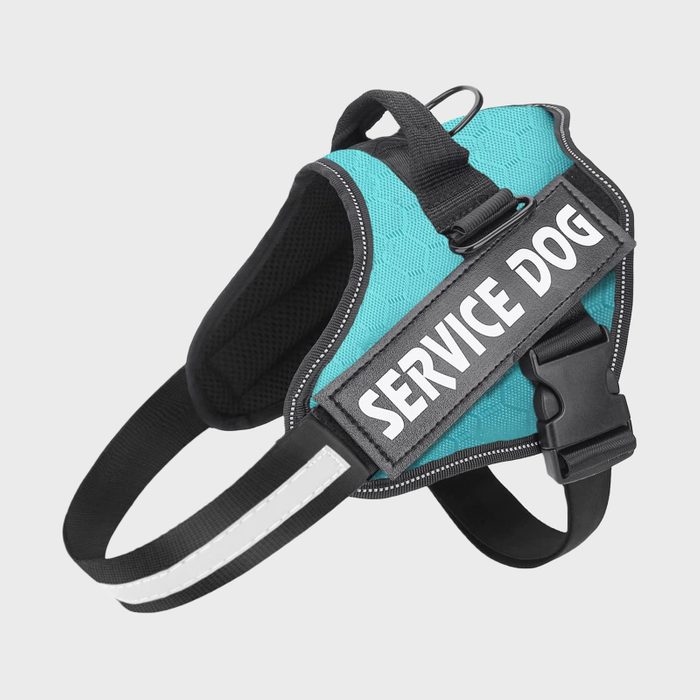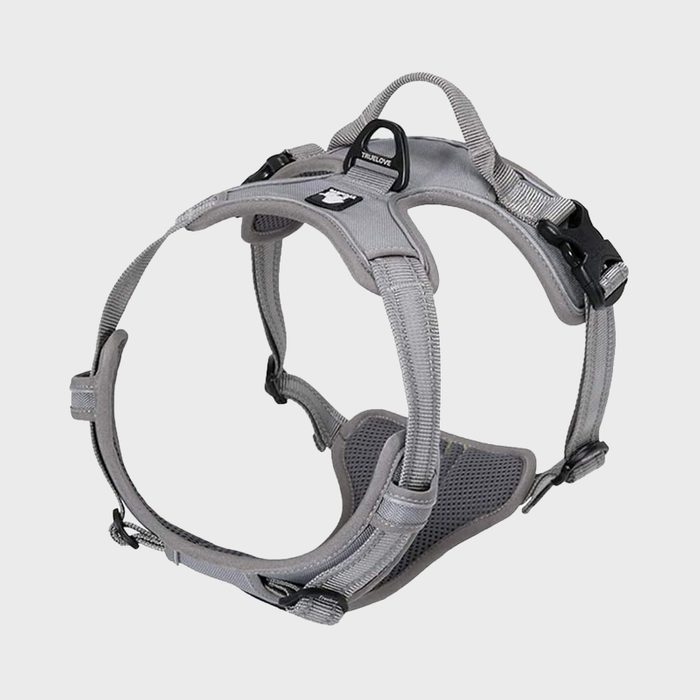via merchant
via merchant
Pros:
-
Has two leash attachment points and included leash
-
Comes in 19 colors and patterns
-
Made with velvet padding
-
Has four adjustment points
-
Made in USA
Cons:
-
Straps go across the shoulders
-
Some reviews noted fraying of the material
Several trainers listed the Freedom harness as a top pick. Dog trainer and expert Greta Kaplan of Fuzzy Logic Dog Training, explains that for heavy pullers who need more control, the Freedom harness can help. It’s just not as ergonomic as other top choices. “The Freedom does have straps across the shoulder joint, which makes me cringe,” Kaplan says, noting it’s not as terrible as the worst offenders that usually sit higher on the dog. “The velvet girth is a little easier on armpits for thin-coated types.”
Dog trainer Beth Hrnciar, agrees. “I love them because of their ease of use, huge selection of colors and prints and the ability to use both front and rear connections individually or simultaneously,” she says. She notes that these harnesses are a game-changer and give owners immediate relief. It offers solid construction with several points of contact to adjust fit for even the most oddly shaped bodies.
via merchant
via merchant
Pros:
-
Has a removable Velcro patch that says “service dog”
-
Affordable price point
-
Comes in six sizes and multiple colors and patterns
-
Takes 10 seconds to go on or off
-
Buckles are padded
Cons:
-
Front strap rides across shoulders
-
Velcro fasteners can stick to fur
Charity Marie Starrett, a dog trainer and handler of service dogs, uses this Mumupet service dog harness with her golden retriever mix, Max. “He managed to get out of every single harness I’ve ever bought him except this one. He has yet to outsmart it,” she says, noting it doesn’t bother him or chafe in any way. Her second service dog, Rory, chewed up other harnesses, but Rory also accepts this one.
Starrett likes the Mumupet for the easy way it goes on and off in 10 seconds or less. “Our dogs will put their head through voluntarily, because they recognize it is work time and they like doing work. Then, clip one strap around them behind the front legs,” she explains. Also, it’s easy to clean and lasts for years. “For less than $20, I highly recommend this product. I bought it in 2020 and still use it any time I take our dogs anywhere,” she says.
Don’t have a service dog? Though the photo shows the service dog label, you don’t have to use the velcro tags that come with the harness.
via merchant
via merchant
Pros:
-
Fits dogs with up to a 40-inch chest
-
Has a padded chest and belly area
-
Available in 11 colors and five sizes
-
Includes a handle on the back
Cons:
-
Reviewers note that clips are stiff
Jane Hadfield, trainer at Bigpaw training, specializes in big and giant breed dogs of 120 pounds or more. Owners of these dogs have limited options finding appropriate equipment that fits. “We recently successfully switched a client’s 175-pound Dane to a front-attach harness,” she says. “For particularly strong pullers under 40 inches at the girth, we prefer a Y-design front-attach, such as the True Love.” The Y-front can help prevent the harness from slipping around on a particularly strong puller, and the back attachment clipped onto a long line for recall training.
What to consider when buying a no-pull dog harness
The best no-pull dog harnesses should have:
- An ergonomically designed Y-shape: This harness shape leaves the shoulders unconstricted, allowing for a full range of movement.
- Multiple adjustment points: The best no-pull dog harness needs to have a customized fit. The harness should have detailed measuring instructions, the same way you’d pay attention to sizing dog boots.
- Well-padded straps: This will prevent your dog’s skin from chafing.
- Two leash attachment points: You can use the back leash connection to secure dogs with a seat belt in the car, or clip in both the front and back with a double leash for additional control during walks and training.
There are some things to avoid while you shop. “Any harness with straps across the shoulder joint is out,” says Kaplan. The earliest popular no-pull harnesses still use this H-type design in which a strap crosses the front of the dog’s breast. When the harness tightens, this strap restricts normal shoulder action, changes normal gait and, in the worst cases, injures a tugging dog.
Harnesses that tightly hug in the armpits or chafe the dog’s front legs are also out. Besides being uncomfortable, the tightness can increase a dog’s anxiety. Also, steer clear of harnesses made from harsh, inflexible material that can chafe dogs with short or thin fur. Those with thick fur have a bit more padding, but also benefit from padded straps and softer, more flexible material that offers comfort for the dog.
Why you should trust us
I am a certified animal behavior consultant and the author of 35-plus pet-care books. I began my career as a veterinary technician and now write for the veterinary and pet products industry. I used my years of experience with dogs to curate the best no-pull dog harnesses.
To help with this piece, I consulted several dog trainers, behaviorists and experts to get their opinions on the best no-pull harness.
- Julia Robertson is a canine expert in canine myotherapy, a specialized massage technique.
- Trish Ryan, PMCT is a Pat Miller-certified dog trainer. She is also an Online Faculty Advisor for Victoria Stilwell Academy and the owner-trainer at ForPawDrive.com.
- Nancy Brunswick is a Karen Pryor Academy-certified training partner.
- Sassafras Lowrey is a Certified Trick Dog Instructor and American Kennel Club CGC evaluator. He is also the author of Tricks in the City and writes about dog training for The New York Times and the American Kettle Club.
- Julie Davidson is a member of the Association of Pet Dog Trainers and Pet Professional Guild. She’s also a trainer at 4 On the Floor Training in Montgomery County, Maryland.
- Dianna L. Stearns, MA, CPDT-KA, CDBC and CATT, trains dogs at Capital Training and Behavior.
- Greta Kaplan, AB, MA, JD, CDBC and CCUI, is an owner and trainer at Fuzzy Logic Dog Training & Behavior Consulting. She is also a fully certified member of the International Association of Animal Behavior Consultants and one of the first Certified Control Unleashed instructors.
- Beth Hrnciar is a member of the Pet Professional Guild and trains dogs in Connecticut.
- Charity Marie Starrett is a dog trainer and service dog handler. She’s also an award-winning author.
- Jane Hadfield, CPDT-KA, is a trainer specializing in large and giant dog breeds at BigPaw Dog Training in Sydney, Australia.
How we found the best no-pull dog harnesses
When selecting the best no-pull dog harnesses, we began by researching a wide range of available options, considering factors such as size, material, design and price point. We also looked for harnesses that catered to specific dogs, including puppies, large dogs, service dogs and heavy pullers. To narrow down our choices, we analyzed customer reviews to understand each no-pull dog harness’s real-world performance and durability. Finally, we consulted with dog experts to understand why these particular harnesses work so well.
FAQ
Why do dogs pull?
You might think dogs pull against the leash to get their way. Or maybe the lure of sniffing and exploring keeps them from thinking straight. Pet lovers often mistakenly think their dogs want to be in charge. The reality comes down to nature. Pulling (or pushing) against an opposing force is a hard-wired reflex. That’s why when you want to brush your dog’s teeth (yes, you should!), your pooch leans away. Dogs have trouble controlling this natural inclination—and so do people.
The opposition reflex prompts dogs to counter pressure with an opposite action. When a dog feels pressure against their throat from the collar, they reflexively move against it. The added pressure from the leash increases opposition reflex so much that dogs willingly injure themselves. Dangerous pressure against the fragile structures of the neck affects dogs’ muscles, breathing, nerves and blood supply when they pull hard against a leash. It’s especially dangerous for tiny breeds susceptible to a collapsed trachea.
Are harnesses better than collars?
Attaching the leash to a harness instead of a collar reduces the potential for neck injury in dogs who pull, but it won’t make the opposition reflex go away. And harnesses that aren’t well-designed can actually make pulling worse (think of sled dogs), which means more danger for you, the dog walker. Unfortunately, poorly designed and ill-fitting no-pull dog harnesses can injure your dog.
What are the cons of a no-pull harness?
Not every harness will work well for your dog. One con of no-pull harnesses is that they can cause the leash to tangle easily. A no-pull harness may not be the best fit if you have a particularly active dog that tends to move side to side instead of pulling you forward.




















